
Verkstrand´s Bitter
We make our bitter beverage of ecologically produced and natural herbs. There are no additives, which gives it its pure flavour.It should be noted by diabetics and overweighted that neither any sugar is added, which makes this herb liqueur outstanding compared to other liqueurs on the market. The production - with some modifications - is based on the old Absinthe recipe. Absinthe, an alcoholic mixture which originated as a medicinal elixir in Switzerland, became, by the late 19 th century, a popular alcoholic drink in France and other countries.
Herbs in our beverage:
The aromatic plant Hyssop (lat. Hyssopus officinalis) is one of the oldest known medical herbs - familiar to the ancient greeks and also mentioned in the Bible. Its cleansing properties has been known for a long time. Due to the presence of essential oil constituents in hyssop, it may provide relief for mild irritations of the upper respiratory tract that accompany the common cold. The expectorant action of Hyssop’s essential oil may explain its traditional use for coughs, asthma, and bronchitis. (ref.1).
In recent years there has been published many reports on the antibacterial, antifungal and antiviral properties of the essential oils of aromatic plants (ref.2). Laboratory investigations have demonstrated high antioxidant potency in extracts of Hyssop (ref.3).
Lemom balm (lat. Melissa officinalis) has since Middle Ages been used as an anxiolytic, mild sedative or calming agent. At least one scientific study has found it to be effective in reducing stress (ref.4). Lemon balm and preparations thereof also have shown to improve mood and mental performance (ref.5). In 2003 positive results was achieved in a small clinical trial involving Alzheimer patients with mild to moderate symptoms (ref. 6). Several subsequent studies have provided some evidence of the benefit of Melissa in the treatment of Alzheimer disease but further large-scale, multicenter studies are necessary to determine the effectiveness of herbal medicines in the cognitive deterioration of this disease (ref.7).
The extract of lemon balm has exceptionally high antioxidant activity (ref.8).
Lemon balm exhibits antithyrotropic activity (ref.9) and it is recommended that it should be avoided by those on thyroxin medication.
Fennel (lat. Foenicum vulgare) is a wellknown carminativum, for treating gas colics, both in infants and adults. Fennel is also a source of phytoestrogens and has been used for centuries in the treatment of menstrual and menopausal problems, as well as for fertility problems, but there are no sure scientific evidencies for effects on these problems by fennel intake.
Experimental works have shown that essential oil of fennel, and its main component anethole, has a safe antitrombotic activity (ref.9).
Anethole, the phytochemical of fennel, has been shown to exhibit anticarcinogenic and anti-inflammatory properties (ref.10).
Common wormwood (lat. Artemisia Absinthium) is the plant which gives the spirit Absinthe its name. This plant is mentioned seven times in the Jewish Bible and once in the New Testament, always with the implication of bitterness. The common wormwood held a high reputation in medicine among the Ancients. Its name is influenced by the traditional use as a cure for intestinal worms. This anthelmintic effect has been shown in modern animal experiments (ref.11). Wormwood is nowadays mostly used as a stomach medicine - the bitterness apparently stimulates stomach acid and bile production.
The volatile oil of wormwood contains thujone, which is neurotoxic. At one time the Absinthe had a bad reputation which was connected to presumed high thujone concentrations. However, this connection has now been abandoned and has turned out to be a misinformation (ref.12). The so-called absinthism cannot be distinguished as a distinct syndrome from chronic alcoholism (ref.13).
Recent laboratory research indicates that aqueous wormwood extract has a significant antioxidant activity and protect liver and kidney from heavy metal (lead) -induced toxicity (ref.14).
Cardamonin, a chemical compound of the plant, has been shown to have anti-inflammatory actions. (ref.15).